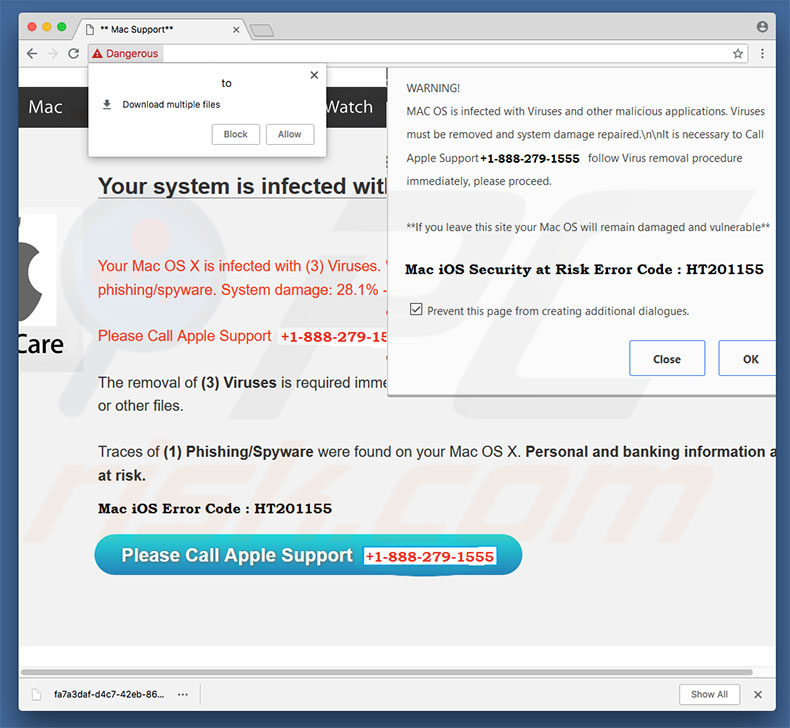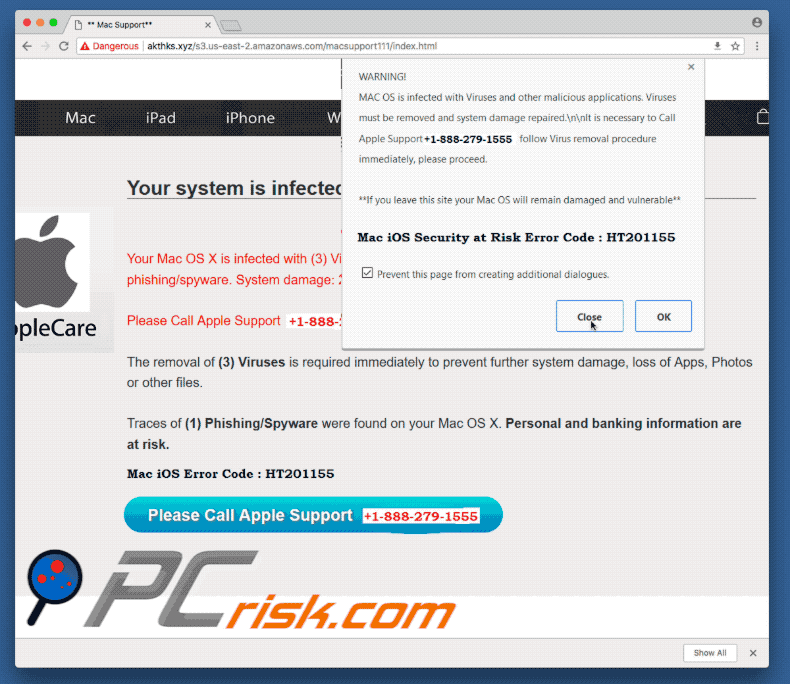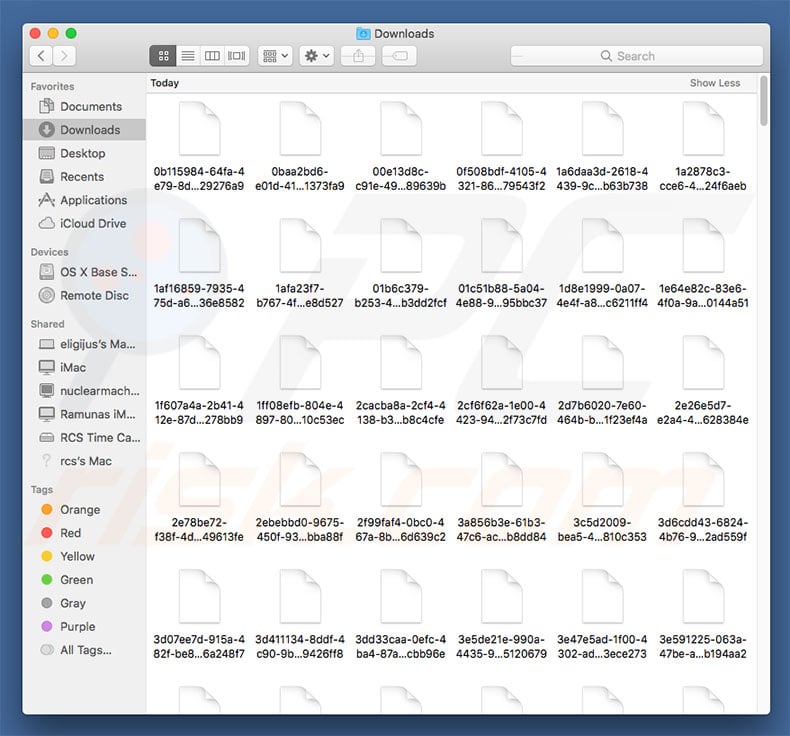Do not trust sites showing "Mac iOS Security At Risk Error Code: HT201155"
Mac VirusAlso Known As: "Mac iOS Security at Risk Error Code: HT201155" virus
Get free scan and check if your device is infected.
Remove it nowTo use full-featured product, you have to purchase a license for Combo Cleaner. Seven days free trial available. Combo Cleaner is owned and operated by RCS LT, the parent company of PCRisk.com.
What is "Mac iOS Security At Risk Error Code: HT201155"?
"Mac iOS Security At Risk Error Code: HT201155" is a fake error message identical to "AppleCare Tech Support Scam". This message is often delivered by deceptive websites, most of which users visit inadvertently - they are redirected by potentially unwanted applications (PUAs) or intrusive ads delivered by other rogue sites.
Research shows that potentially unwanted applications are likely to infiltrate systems without permission. As well as causing redirects, they deploy intrusive advertisements and gather sensitive information.

"Mac iOS Security At Risk Error Code: HT201155" scam overview
The "Mac iOS Security At Risk Error Code: HT201155" pop-up claims that the system is infected and encourages users to immediately call Apple 'tech support' (via the "+1-888-279-1555" telephone number) to resolve all issues. In addition, malicious websites start downloading hundreds of files to crash the browser.
This makes the error message even more believable, since the browser stops responding. Be aware, however, that "Mac iOS Security At Risk Error Code: HT201155" is a scam and Apple has nothing to do with it. Cyber criminals simply aim to generate revenue by tricking unsuspecting users into calling and paying for 'tech support' that is not required.
Your computer is probably optimized and virus free. You can remove the "Mac iOS Security At Risk Error Code: HT201155" error simply by closing the browser, however, if it is not responding or the website use scripts to disables closing of browsing tabs/windows, you should terminate the browser via Task Manager or reboot the system.
After re-running the browser, do not restore the previous session, otherwise the malicious websites will be reopened.
Potentially unwanted applications deliver coupon, banner, pop-up, and other intrusive advertisements. These are delivered using tools that enable placement of third party graphical content on any site. Therefore, they often conceal underlying content, thereby significantly diminishing the browsing experience.
In addition, intrusive ads can lead to infectious websites and execute scripts that download and install malware. Therefore, clicking them risks various computer infections. Potentially unwanted applications are also known to record information relating to browsing activity.
Collected data (IP addresses, URLs visited, pages viewed, search queries, and so on) typically includes personal details that developers share with third parties (potentially, cyber criminals) who misuse it to generate revenue. The presence of these applications might lead to serious privacy issues or even identity theft. Remove them immediately.
| Name | "Mac iOS Security at Risk Error Code: HT201155" virus |
| Threat Type | Mac malware, Mac virus |
| Symptoms | Your Mac became slower than normal, you see unwanted pop-up ads, you get redirected to shady websites. |
| Distribution methods | Deceptive pop-up ads, free software installers (bundling), fake flash player installers, torrent file downloads. |
| Damage | Internet browsing tracking (potential privacy issues), displaying of unwanted ads, redirects to shady websites, loss of private information. |
| Malware Removal (Windows) |
To eliminate possible malware infections, scan your computer with legitimate antivirus software. Our security researchers recommend using Combo Cleaner. Download Combo CleanerTo use full-featured product, you have to purchase a license for Combo Cleaner. 7 days free trial available. Combo Cleaner is owned and operated by RCS LT, the parent company of PCRisk.com. |
There are dozens of fake error messages similar to "Mac iOS Security At Risk Error Code: HT201155". All claim that the system is damaged , however, these claims are merely attempts to trick unsuspecting users into paying for unnecessary tech support or purchasing useless software (typically fake anti-virus suites).
By offering "useful features", PUAs often convince users that they are legitimate and useful, however, these apps are designed only to generate revenue for the developers. Rather than enabling the functionality promised, they gather information, cause redirects, and deliver ads, thereby posing a direct threat to your privacy and Internet browsing safety.
How did potentially unwanted applications install on my computer?
In some cases, potentially unwanted applications have official download websites, however, due to the lack of knowledge and careless behavior of many users, these apps often infiltrate systems without consent.
Most are distributed using intrusive advertisements and a deceptive marketing method called "bundling" (stealth installation of potentially unwanted applications together with regular software/apps). Developers are not honest enough to disclose PUA installations properly.
Therefore, all are hidden within "Custom/Advanced" settings (or other sections) of the download/installation processes. In this way, users expose their systems to risk of various infections by clicking advertisements and skipping most download/installation steps. This behavior often leads to inadvertent installation of PUAs.
How to avoid installation of potentially unwanted applications?
To prevent system infiltration by potentially unwanted applications, pay close attention during the download/installation processes and when browsing the Internet. Carefully analyze each download/installation step and opt-out of all additionally-included programs.
We also recommend that you avoid using third party downloaders/installers, since developers monetize them by promoting PUAs. Software should be downloaded from official sources only, using direct download links.
Developers invest a great deal of time and resources into intrusive ad design, thereby making them seem legitimate, but most redirect to dubious websites (pornography, adult dating, survey, etc.) If you encounter these redirects, check the list of installed apps/browser plug-ins and eliminate any suspicious entries.
The main reasons for computer infections are poor knowledge and careless behavior. The key to safety is caution. If your computer is already infected with PUAs, we recommend running a scan with Combo Cleaner Antivirus for Windows to automatically eliminate them.
Text presented in "Mac iOS Security At Risk Error Code: HT201155" pop-up:
WARNING!
MAC OS is infected with Viruses and other malicious applications. Viruses must be removed and system damage repaired. It is necessary to Call Apple Support +1-888-279-1555 follow Virus removal procedure immediately, please proceed.
** If you leave this site your Mac OS will remain damaged and vulnerable **
Mac iOS Security at Risk Error Code: HT201155
Traces of (1) Phishing/Spyware were found on your Mac OS X. Personal and banking information are at risk.
Max iOS Error Code: HT201155
Please Call Apple Support +1-888-279-1555
Appearance of "Mac iOS Security At Risk Error Code: HT201155" scam (GIF):

Screenshot of files downloaded by deceptive websites that deliver "Mac iOS Security At Risk Error Code: HT201155" pop-up:

Note that these files are harmless and you safely delete them. Websites download them just to crash the web browser.
Instant automatic malware removal:
Manual threat removal might be a lengthy and complicated process that requires advanced IT skills. Combo Cleaner is a professional automatic malware removal tool that is recommended to get rid of malware. Download it by clicking the button below:
DOWNLOAD Combo CleanerBy downloading any software listed on this website you agree to our Privacy Policy and Terms of Use. To use full-featured product, you have to purchase a license for Combo Cleaner. 7 days free trial available. Combo Cleaner is owned and operated by RCS LT, the parent company of PCRisk.com.
Quick menu:
- What is "Mac iOS Security at Risk Error Code: HT201155" virus?
- How to identify a pop-up scam?
- How do pop-up scams work?
- How to remove fake pop-ups?
- How to prevent fake pop-ups?
- What to do if you fell for a pop-up scam?
How to identify a pop-up scam?
Pop-up windows with various fake messages are a common type of lures cybercriminals use. They collect sensitive personal data, trick Internet users into calling fake tech support numbers, subscribe to useless online services, invest in shady cryptocurrency schemes, etc.
While in the majority of cases these pop-ups don't infect users' devices with malware, they can cause direct monetary loss or could result in identity theft.
Cybercriminals strive to create their rogue pop-up windows to look trustworthy, however, scams typically have the following characteristics:
- Spelling mistakes and non-professional images - Closely inspect the information displayed in a pop-up. Spelling mistakes and unprofessional images could be a sign of a scam.
- Sense of urgency - Countdown timer with a couple of minutes on it, asking you to enter your personal information or subscribe to some online service.
- Statements that you won something - If you haven't participated in a lottery, online competition, etc., and you see a pop-up window stating that you won.
- Computer or mobile device scan - A pop-up window that scans your device and informs of detected issues - is undoubtedly a scam; webpages cannot perform such actions.
- Exclusivity - Pop-up windows stating that only you are given secret access to a financial scheme that can quickly make you rich.
Example of a pop-up scam:

How do pop-up scams work?
Cybercriminals and deceptive marketers usually use various advertising networks, search engine poisoning techniques, and shady websites to generate traffic to their pop-ups. Users land on their online lures after clicking on fake download buttons, using a torrent website, or simply clicking on an Internet search engine result.
Based on users' location and device information, they are presented with a scam pop-up. Lures presented in such pop-ups range from get-rich-quick schemes to fake virus scans.
How to remove fake pop-ups?
In most cases, pop-up scams do not infect users' devices with malware. If you encountered a scam pop-up, simply closing it should be enough. In some cases scam, pop-ups may be hard to close; in such cases - close your Internet browser and restart it.
In extremely rare cases, you might need to reset your Internet browser. For this, use our instructions explaining how to reset Internet browser settings.
How to prevent fake pop-ups?
To prevent seeing pop-up scams, you should visit only reputable websites. Torrent, Crack, free online movie streaming, YouTube video download, and other websites of similar reputation commonly redirect Internet users to pop-up scams.
To minimize the risk of encountering pop-up scams, you should keep your Internet browsers up-to-date and use reputable anti-malware application. For this purpose, we recommend Combo Cleaner Antivirus for Windows.
What to do if you fell for a pop-up scam?
This depends on the type of scam that you fell for. Most commonly, pop-up scams try to trick users into sending money, giving away personal information, or giving access to one's device.
- If you sent money to scammers: You should contact your financial institution and explain that you were scammed. If informed promptly, there's a chance to get your money back.
- If you gave away your personal information: You should change your passwords and enable two-factor authentication in all online services that you use. Visit Federal Trade Commission to report identity theft and get personalized recovery steps.
- If you let scammers connect to your device: You should scan your computer with reputable anti-malware (we recommend Combo Cleaner Antivirus for Windows) - cyber criminals could have planted trojans, keyloggers, and other malware, don't use your computer until removing possible threats.
- Help other Internet users: report Internet scams to Federal Trade Commission.
Frequently Asked Questions (FAQ)
What is a pop-up scam?
Pop-up scams are deceptive messages intended to trick users into performing specific actions. For example, victims can be enticed/scared into calling fake helpline, allowing cyber criminals to access devices remotely, making monetary transactions, disclosing vulnerable information, downloading/installing programs, purchasing products, and so on.
What is the purpose of a pop-up scam?
Pop-up scams aim to generate revenue at victims' expense. Profit can be made by acquiring funds through deception, promoting content (e.g., websites, software, products, etc.), selling/abusing private data, and spreading malware.
Why do I encounter fake pop-ups?
Pop-up scams are mainly promoted via websites using rogue advertising networks, mistyped URLs, intrusive ads, spam (e.g., emails, DMs/PMs, SMSes, browser notifications, etc.), and adware.
I cannot exit a scam page, how do I close it?
If you cannot exit a deceptive webpage – end the browser's process using the Activity Monitor (Task Manager on Windows). Start a new browsing session when relaunching the browser, as the previous one includes the scam page.
I have allowed cyber criminals to remotely access my computer, what should I do?
If you have allowed cyber criminals to remotely access your computer – you must first disconnect it from the Internet. Afterward, uninstall the remote access program that the scammers used (e.g., TeamViewer, UltraViewer, etc.), as they might not need your permission to reconnect. Lastly, perform a full system scan with an anti-virus and eliminate all detected threats.
I have provided my personal information when tricked by a pop-up scam, what should I do?
If you have provided your log-in credentials – change the passwords of all possibly exposed accounts and inform their official support without delay. And if you've disclosed other private data (e.g., ID card details, passport scans/photos, credit card numbers, etc.) – immediately contact the appropriate authorities.
Will Combo Cleaner protect me from pop-up scams and the malware they proliferate?
Combo Cleaner is designed to detect and eliminate all kinds of threats. It can scan visited websites for deceptive/malicious content, as well as block all further access to such pages. Additionally, Combo Cleaner can detect and remove most of the known malware infections. Note that high-end malicious programs typically hide deep within systems – hence, running a full system scan is crucial.
Share:

Tomas Meskauskas
Expert security researcher, professional malware analyst
I am passionate about computer security and technology. I have an experience of over 10 years working in various companies related to computer technical issue solving and Internet security. I have been working as an author and editor for pcrisk.com since 2010. Follow me on Twitter and LinkedIn to stay informed about the latest online security threats.
PCrisk security portal is brought by a company RCS LT.
Joined forces of security researchers help educate computer users about the latest online security threats. More information about the company RCS LT.
Our malware removal guides are free. However, if you want to support us you can send us a donation.
DonatePCrisk security portal is brought by a company RCS LT.
Joined forces of security researchers help educate computer users about the latest online security threats. More information about the company RCS LT.
Our malware removal guides are free. However, if you want to support us you can send us a donation.
Donate
▼ Show Discussion